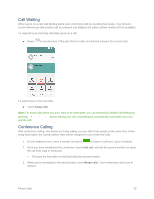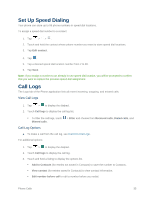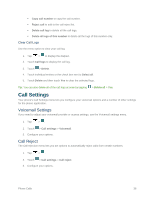LG LS660 Virgin Mobile Owners Manual - English - Page 45
TTY Mode, System settings, TTY Full, TTY HCO, TTY Off
 |
View all LG LS660 Virgin Mobile manuals
Add to My Manuals
Save this manual to your list of manuals |
Page 45 highlights
TTY Mode A TTY (teletypewriter, also known as a TDD or Text Telephone) is a telecommunications device that allows people who are deaf, hard of hearing, or who have speech or language disabilities, to communicate by telephone. Your phone is compatible with select TTY devices. Please check with the manufacturer of your TTY device to ensure that it supports digital wireless transmission. Your phone and TTY device will connect using a special cable that plugs into your phone's headset jack. If this cable was not provided with your TTY device, contact your TTY device manufacturer to purchase the connector cable. To turn TTY Mode on or off: 1. Tap > touch and hold > System settings > Call > TTY mode. 2. Touch TTY Full, TTY HCO, or TTY VCO to turn TTY mode on. - or - Touch TTY Off to turn TTY mode off. Note: When enabled, TTY mode may impair the audio quality of non-TTY devices connected to the headset jack. Warning: 9-1-1 Emergency Calling It is recommended that TTY users make emergency calls by other means, including Telecommunications Relay Services (TRS), analog cellular, and landline communications. Wireless TTY calls to 9-1-1 may be corrupted when received by public safety answering points (PSAPs), rendering some communications unintelligible. The problem encountered appears related to TTY equipment or software used by PSAPs. This matter has been brought to the attention of the FCC, and the wireless industry and the PSAP community are currently working to resolve this. Phone Calls 37















